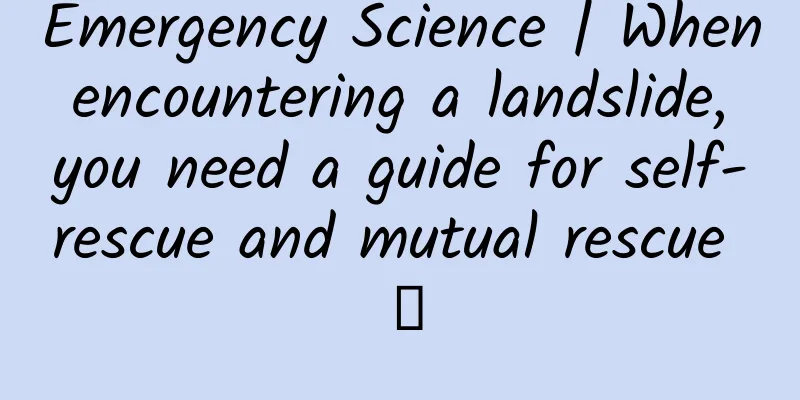Emergency Science | When encountering a landslide, you need a guide for self-rescue and mutual rescue →

|
At about 11:50 on February 8, a landslide occurred in Jinping Village, Muai Town, Yunlian County, Yibin City, Sichuan Province, burying houses and causing loss of contact with people. Currently, emergency rescue work is in full swing. Disasters are ruthless and they touch our hearts. On February 9, Yibin City, Sichuan Province held a press conference and initially determined that the disaster was caused by the recent continuous rainfall and geological conditions, which caused the high-altitude landslide to transform into a debris flow, forming a debris accumulation body about 1.2 kilometers long. The landslide body is about 10 to 20 meters thick and about 100 meters wide, with a landslide volume of more than 100,000 cubic meters. On February 9, various rescue forces were searching for trapped people (Photo by Xinhua News Agency reporter Jiang Hongjing) Landslides are a common geological disaster that occurs suddenly, violently, and with great destructive power, often causing significant loss of life and property. Which areas are prone to landslides? How should we deal with landslides scientifically? 01What is a landslide? Landslide refers to the natural phenomenon that soil or rock on the slope of a mountain becomes unstable due to factors such as rainfall, river scouring, groundwater activity, earthquakes or artificial slope cutting, and slides down the slope in whole or in part along a certain weak structural surface or structural belt under the action of gravity. It is commonly known as "landing". The occurrence of landslides is related to factors such as the height difference of the slope terrain, the rock properties of the slope, the geological structure, and human activities. Among them, excavation at the foot of the slope, water storage at the foot of the slope, and drainage at the top of the slope are common man-made factors that induce landslides, while earthquakes, rainfall, freeze-thaw, river erosion and soaking are common natural factors that induce landslides. The picture is a copyrighted stock picture. Reprinting it may cause copyright disputes. 02How to save yourself and others in the event of a sudden landslide? (1) When encountering a landslide while walking Stay calm, look around, and determine your distance and position from the landslide as quickly as possible. If you find yourself at the front edge or upper part of a landslide, flee at the fastest speed in a direction perpendicular to the direction of the landslide and find a safe area as soon as possible. If you find yourself in the middle of a landslide and cannot escape, find an open area with a gentle slope as soon as possible, away from houses, electric poles or other buildings to avoid secondary injuries. In other situations where you cannot escape, quickly hold onto a nearby tree or other fixed object or hide behind a solid obstacle, lie prone, cover yourself, hold on tightly, and protect your head. The picture is a copyrighted stock picture. Reprinting it may cause copyright disputes. (2) When driving and encountering a landslide If you find a landslide ahead, stop the car immediately and do not try to rush forward or race against the slope. If you find a landslide behind your car, drive away from the danger zone immediately. When you find a landslide right under your car, abandon the car and flee. (3) Precautions after landslide Do not re-enter the landslide area to search for damaged or lost personal property. Do not return home immediately to check the situation to avoid being harmed by a second landslide or other secondary disasters. When people are found buried, under the premise of ensuring personal safety, the scale of the disaster and the number of buried people should be reported to the relevant departments as soon as possible, and rescue efforts should be launched as soon as possible within the 72-hour golden time to minimize casualties. 03 Avoiding landslides is important to identify precursors Landslides are extremely destructive and dangerous. Although they are often beyond human control, we can understand the precursor characteristics exposed before they erupt and take risk avoidance measures such as evacuation as soon as possible. Landform signs: The surface of the soil or rock mass is steep and long, with uneven slopes or unevenly sunken platforms; the soil or rock mass is gently inclined downward and has not been leveled; there are springs or wetlands on the surface of the soil or rock mass, and gullies are developed; the soil and rocks at the front edge of the soil or rock mass are loose, and the foot of the slope is watered or washed by river water; there are no upright trees on the upper part of the soil or rock mass. Precursors of landslide: The flow of spring water at the bottom of the slope or around it suddenly becomes abnormal, or spring water suddenly appears at the bottom of the slope; the well water around the rock mass suddenly "revives" or dries up, or the water volume suddenly changes; cracks appear in the walls of houses around the soil or rock mass, and gradually widen and deepen; small collapses and loosening of the rock mass around the slope or land; cracking or shearing and squeezing sounds are heard in the rocks around the land or rock mass; abnormal animals appear around the land or rock mass, and trees tilt or suddenly wither, etc. Observe the weather: Rainfall is an important factor in inducing landslides, especially during rainfall or within a period of time after continuous rainfall. Therefore, you must pay attention to the weather forecast and do not walk in valleys or near high-cut slopes during heavy rain. Pay attention to the season: In addition to the rainy season, in the north and northwest of my country, from March to May, the seasonal frozen soil thaws. It is also the peak period for landslides! In spring, as the temperature rises rapidly, the ice and snow melt, the soil thaws, and the freeze-thaw geological disasters begin to enter the peak period. Therefore, when going out at this time of year, be sure to stay away from the loess high-cut slopes. The picture is a copyrighted stock picture. Reprinting it may cause copyright disputes. 04 Be alert! Secondary disasters that need to be prevented ▪Secondary landslide or collapse disasters: the back wall and the free surfaces on both sides of the landslide source area are high-risk areas for secondary landslides. ▪There is a possibility of debris flow. After the landslide occurs, a large amount of loose deposits will be formed. Under conditions of heavy rainfall, a debris flow disaster is very likely to occur. ▪If the landslide blocks the river channel, it will form a barrier lake, causing the river water to flow backwards. After the barrier lake bursts, it will cause a major flood. Author: Liu Hanbin, PhD in Geology, Senior Engineer Reviewer: Zhang Ying, Director of the China Science Writers Association, Executive Vice Chairman and Secretary General of the Emergency Science Popularization Committee Produced by: Science Popularization China Note: The cover image is a copyrighted image. Reprinting it may cause copyright disputes. |
>>: The nutritional truth about “wild game”: Is it a tonic or a health trap?
Recommend
AlphaGo is just the beginning, artificial intelligence will usher in an explosion
The final round of the man-machine Go battle came...
14 self-media publishing platforms and commonly used new media operation tools!
Today, the editor has compiled some tools that yo...
How to analyze live streaming traffic!
There are two topics today. The first one is &quo...
What wonders will happen when a matter sun and an antimatter sun collide?
This is an answer to a question invited by netize...
Analysis of GuangDianTong information flow optimization techniques!
Guangdiantong is one of Tencent’s two major infor...
Spring Guardian Guide: How to deal with pollen allergies?
March is supposed to be a good time for everythin...
Case practice: How can lottery activities attract users?
Last night, there was a very interesting discussi...
The Dirtiest Thing on Eggs: You Might Be Eating Them! (Not What You Think)
Eggs are rich in nutrients. As an essential ingre...
The “refined” community operation routines of online education!
In the online education sector, course communitie...
The seemingly alien "vampire" is actually a "living fossil" on Earth that existed much earlier than the dinosaurs
Lampreys are one of the oldest vertebrates on Ear...
Memory/SSD prices are skyrocketing! Will there be no price reduction this year?
At the beginning of the new year, among all DIY h...
The first batch of 8 5G mobile phones obtained 3C certification: Huawei accounted for 4, and Xiaomi was not seen
[[270878]] On July 16, a reporter from the Daily ...
Google Ads Promotion: How to Improve Keyword Rankings?
01. How can I rank at the top of search results? ...
How do you pronounce these common bronze wares, such as yan, fu, jia, yi, hu, lei, you?
Bronze ware is the witness and carrier of the ori...









